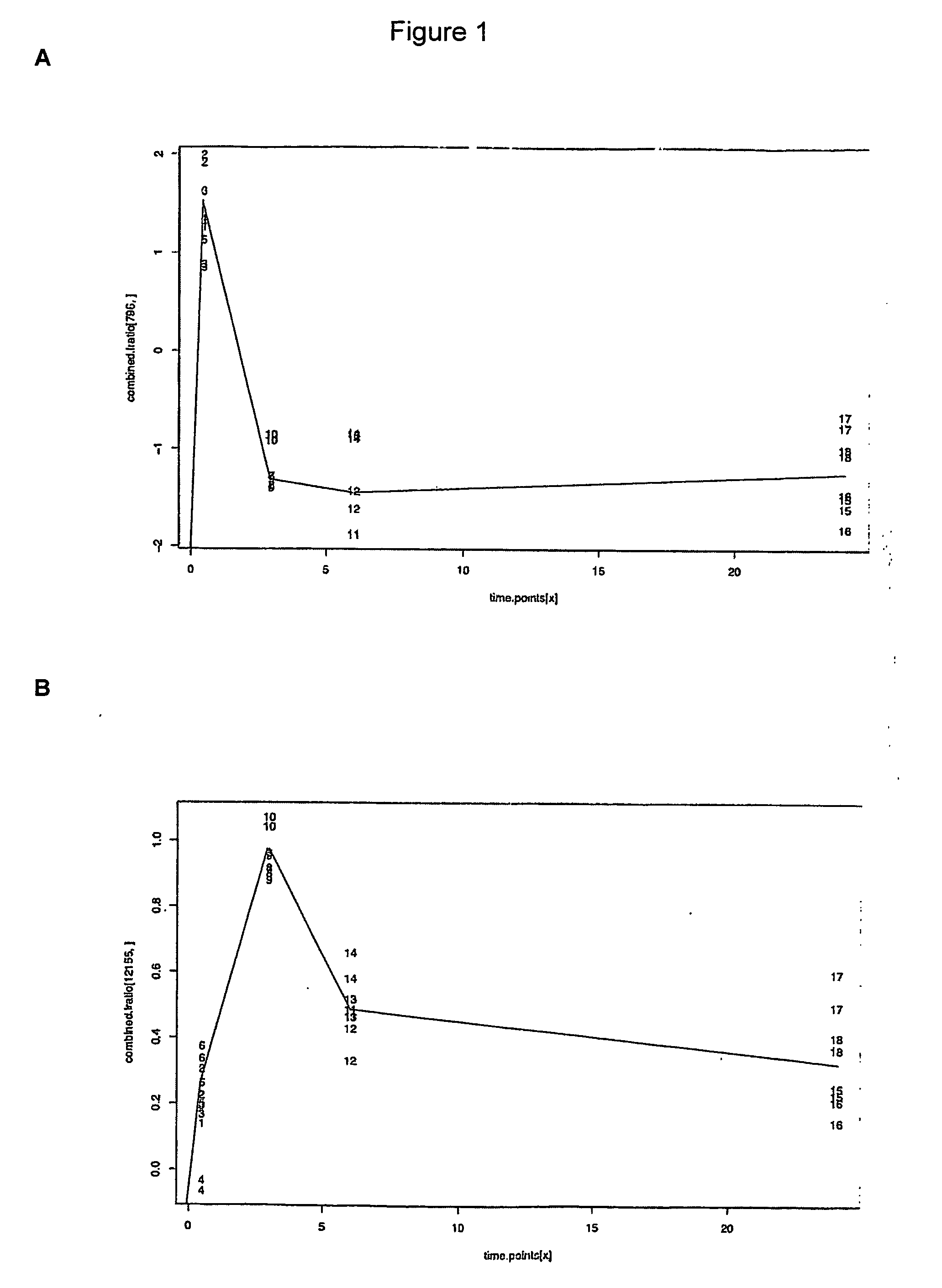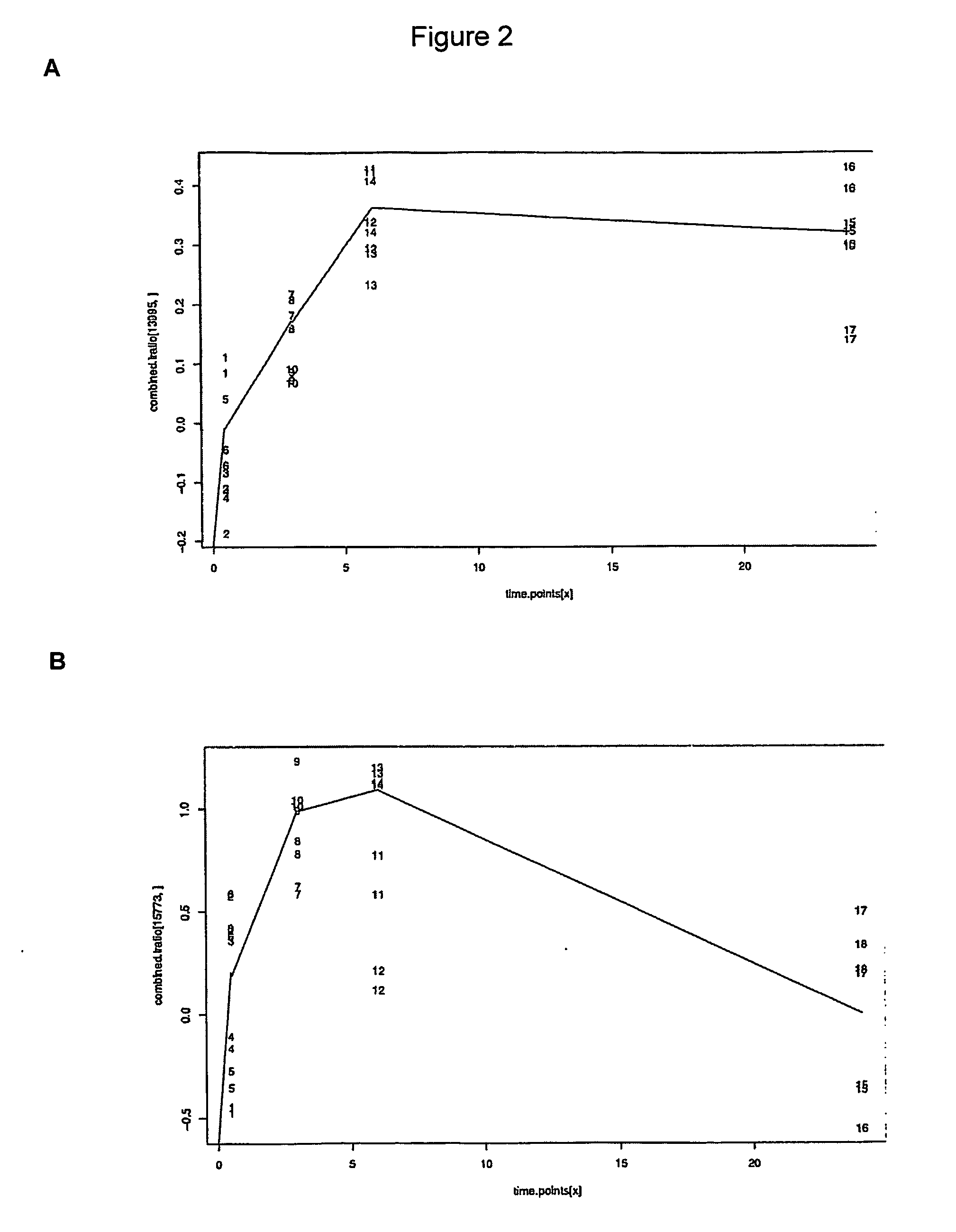Method for identifying nucleic acid molecules associated with angiogenesis
a nucleic acid and angiogenesis technology, applied in the field of new nucleic acid sequences, can solve the problems of enhanced angiogenesis, uncontrolled angiogenesis, and little knowledge of cell morphology changes
- Summary
- Abstract
- Description
- Claims
- Application Information
AI Technical Summary
Benefits of technology
Problems solved by technology
Method used
Image
Examples
example 1
In Vitro Capillary Tube Formation
[0148] The in vitro model of angiogenesis is essentially as described in Gamble et al (1993). The assay was performed in collagen under the stimulation of phorbol myristate acetate (PMA) and the anti-integrin (α2β1) antibody, RMACII. Human umbilical vein endothelial cells (HUVECs) were used in all experiments between passages 2 to 4.
[0149] Cells were harvested from bulk cultures (t=0), replated onto the collagen gels with stimulation and then harvested from the collagen gels at 0.5, 3.0, 6.0 and 24 hours after commencement of the assay. These time points were chosen since major morphological changes occur at these stages. Briefly, by 0.5 hours, cells have attached to the collagen matrix and have commenced migration into the gel. By 3.0 hours, small intracellular vesicles are visible. By 6.0 hours, these vesicles are coalescing together to form membrane bound vacuoles and the cells in the form of short sprouts have invaded the gel. After this time, ...
example 2
RNA Isolation, cDNA Synthesis and Amplification
[0150] Cells harvested at the specified time points were used for the isolation of total RNA using the Trizol reagent (Gibco BRL) according to manufacturers conditions. SMART (Switching mechanism at 5′ end of RNA transcript) technology was used to convert small amounts of total RNA into enough cDNA to enable cDNA subtraction to be performed (see below). This was achieved using the SMART-PCR cDNA synthesis kit (Clontech-user manual PT3041-1) according to manufacturers recommendations. The SMART-PCR cDNA synthesis protocol generated a majority of full length cDNAs which were subsequently PCR amplified for cDNA subtraction.
example 3
Suppression Subtractive Hybridization (SSH)
[0151] SSH was performed on SMART amplified cDNA in order to enrich for cDNAs that were either up-regulated or down-regulated between the cDNA populations defined by the selected time-points. This technique also allowed “normalisation” of the regulated cDNAs, thereby making low abundance cDNAs (i.e. poorly expressed, but important, genes) more easily detectable. To do this, the PCR-Select cDNA synthesis kit (Clontech-user manual PT3041-1) and PCR-Select cDNA subtraction kit (Clontech-user manual PT1117-1) were used based on manufacturers conditions.
[0152] These procedures relied on subtractive hybridization and suppression PCR amplification. SSH was performed between the following populations: 0-0.5 hours; 0.5-3.0 hours; 3.0-6.0 hours; 6.0-24 hours.
PUM
| Property | Measurement | Unit |
|---|---|---|
| Fraction | aaaaa | aaaaa |
| Fraction | aaaaa | aaaaa |
| Fraction | aaaaa | aaaaa |
Abstract
Description
Claims
Application Information
 Login to View More
Login to View More - R&D
- Intellectual Property
- Life Sciences
- Materials
- Tech Scout
- Unparalleled Data Quality
- Higher Quality Content
- 60% Fewer Hallucinations
Browse by: Latest US Patents, China's latest patents, Technical Efficacy Thesaurus, Application Domain, Technology Topic, Popular Technical Reports.
© 2025 PatSnap. All rights reserved.Legal|Privacy policy|Modern Slavery Act Transparency Statement|Sitemap|About US| Contact US: help@patsnap.com



